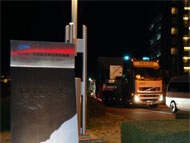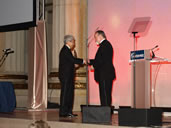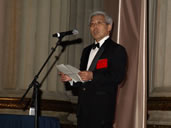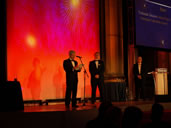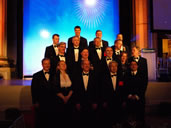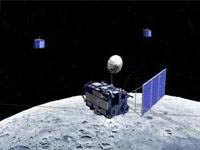
In addition in "Information" page, you can view the various informations regarding KAGUYA.
Information
Let me express the greetings of the season.
May the New Year turn out to be the happiest and the best for you.
I look forward to your continued good will in the coming year.
Screening the High-Defintion moon footage, shot by the "KAGUYA" as part of the Science Museum of United Kingdom at 26 june 2009, 17:00 - 22:00 (GMT).
super/cinema : super/collider http://www.super-collider.com/supercinema/
Since the lunar orbiter KAGUYA will plan to slam into the Moon at 6:30pm on Wednesday, June 10, 2009(GMT), team "SELENE (KAGUYA)" works to prepare the final operation to impact in the Moon's southern hemisphere, near the Gill crater to get the skill of controlled re-entry (or impact) with high accuracy. In addition, it may be the last promotion activity for KAGUYA project by using KAGUYA (SELENE) satellite itself for people around the world.
From this page, if someone plans to see the KAGUYA impact at observatory with big telescope like as 3.6 meter telescope in Hawaii, please contact with us by e-mail (sel_hp@jaxa.jp) and let us know who, how and where. In addition, it is very appreciated if you can also provide the result of observation.
REMINDER: Impact time / location information will be updated by using the latest information of KAGUYA orbit and satellite condition.
SELENE project EPO staff
Expected KAGUYA impact point
"The Moon and Earth observed by Japan's Lunar Explorer 'Kaguya (SELENE)'" presentation at the Seattle Cherry Blossom & Japanese Cultural Festival (Friday through Sunday April 17 – 19, 2009) on April 18.
Consulate-General of Japan in Seattle
Carried by SCIENCE@NASA, On Feb. 10 (JST), the lunar explorer "KAGUYA" successfully took an image of the moment when the Earth looked like a diamond ring by its onboard high definition camera. (Image: (C) JAXA/NHK)
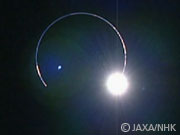
SCIENCE@NASA >>
On Feb. 10 (JST), the lunar explorer "KAGUYA" successfully took an image of the moment when the Earth looked like a diamond ring by its onboard high definition camera. The moment came when a penumbral lunar eclipse (*) occurred and the view of the Sun from the KAGUYA was mostly covered by the Earth, thus the earth looked like a diamond ring. This is the first time that this phenomenon was shot from the Moon. (Image: (C) JAXA/NHK)

* A penumbral lunar eclipse is a phenomenon in which the Sun, Earth and Moon line up in tandem, hence the moon is in the Earth's penumbra, or, when you look from the Moon, the Sun is partially covered by the Earth (partial eclipse.) When the phenomenon occurs, the volume of light from the Sun to the Moon decreases, thus the Moon surface looks darker when you look it from the Earth.
Press release >>
Four KAGUYA research reports using observation data from the Terrain Camera (TC) onboard the KAGUYA and a perspective titled "Seeing the Missing Half" were published as part of a KAGUYA special edition in Science Magazine dated February 13, 2009.
The relay satellite "OKINA (RSTAR)" made an impact on the lunar surface at 19:46 p.m. on February 12, 2009 (JST), and we confirmed that at 0:22 a.m. on the 13th (JST.)
Press release: http://www.jaxa.jp/press/2009/02/20090213_kaguya_e.html
Science Magazine 13 February 2009: http://www.sciencemag.org/content/vol323/issue5916/index.dtl
Screening the High-Defintion moon footage, shot by the "KAGUYA" as part of the Science Museum of United Kingdom. And will be followed by a Q&A with "KAGUYA" project member, live from Japan at evening on 28 january (GMT).
super/cinema : super/collider http://www.super-collider.com/supercinema/
<2009.2.24 added>By the internet TV meeting from 6:00 a.m. of January 29 (JST), the Science Museum of UK as a part of event "about Japan" from Japan. There were participants more than 150 people interested seem to have watched about the KAGUYA and a beautiful picture of HDTV shown locally on that day.
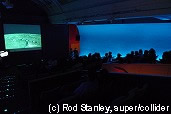
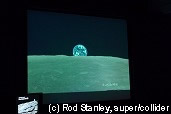
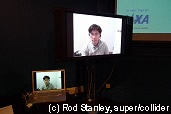
Update the messages from Project Manager.
"KAGUYA Image Gallery" Gravity Anomaly Map from the RSTAR (OKINA) was added.
LALT (Laser Altimeter) topographical map for "Lunar Satellite Orbits 3D" and "Lunar Surface Map" in ODDS (Orbital Data Distribution System).
ODDS : http://odweb.tksc.jaxa.jp/oddse/main.jsp
JAXA Video was opened.
Report & Column in ISAS webpage.
JSPEC website was opened.
http://www.jspec.jaxa.jp/e/index.html
"KAGUYA Image Gallery" The Terrain Camera (TC) image of Apollo 15 landing site was added.
Update the messages from Project Manager.
"KAGUYA Image Gallery" The Terrain Camera (TC) image of Apollo 15 landing site was added.
"KAGUYA Image Gallery" The moon image by High Definition Television (HDTV) was added.
"KAGUYA" pamphlet update on Download page.
NASA, the Planetary Society in Pasadena, Calif., and the Johns Hopkins Applied Physics Laboratory in Laurel, Md. are said with an opportunity to send "personal name" to the moon aboard the Lunar Reconnaissance Orbiter, or LRO.
When name is input with the private sight, the name entered into a database and the database will be placed on a microchip that will be integrated onto the LRO scheduled for launch in late 2008.
Send Your Name to the Moon
Smithsonian National Air and Space Museum
>> Hot topics
>> Hot topics
SELENE (KAGUYA) got aviation week laureate award for space on March 4. It may be first time to receive such award by Japanese mission.
Winners of the 51st Annual Laureate Awards
The following is brief wording from our acceptance message.
SELENE was launched in September 14, last year and represents the largest lunar mission since the Apollo program. Missions of this size and complexity are not without their problems and setbacks, but we are proud in overcoming these and enduring adversity to ensure a successful launch and operation of the spacecraft.
SELENE will investigate the entire moon in order to obtain information on its elemental and mineralogical composition, its geography, its surface and sub-surface structure, the remnants of its magnetic field, and its gravity field. The results are expected to lead to a better overall understanding of the Moon's birth and evolution. Substantial data has already been gathered since we confirmed the operational phase in last December and SELENE mission team members are hard at work to interpret the findings. In addition, we believe that you already had a chance to see the beautiful Earth rise and Earth set high vision movie obtained by SELENE and the movies provide a message the importance of our one fragile small blue planet "Earth".
Japan looks forward to increased cooperation among our exploration efforts with our international partners.
The next SELENE work team meeting will be held early next year to discuss about the SELENE accomplishment during nominal operational phase by this October.
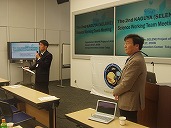
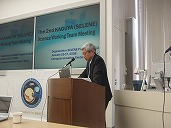
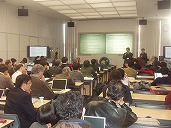
>> Hot topics
>> Press release
>> Press release
>> Press release
"Earth-set" movie taken by the HD camera ( Resolution : 480 x 270 pixels. no audio )


>> WEB release
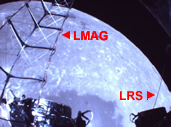
LMAG mast and LRS anntena
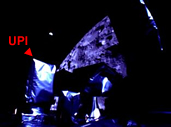
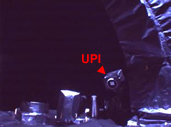
From now on, the satellite will move to the initial check out phase to verify its onboard mission instruments by mid December. After that, it will be nominal operation mode to start nominal observations.
Press release
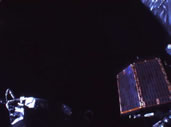
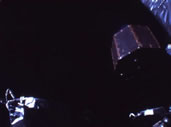
Press release


Press release
Press release
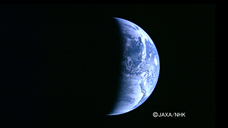

SELENE (KAGUYA) project pursues international collaboration to promote Moon science and future lunar utilization.
International partner agencies members are welcomd to join the historical moment of the SELENE launch. LRO project members are one of them and they also make their blog report to inform of the SELENE launch in cooperation with the planetary society with the following URL.
http://planetary.org/explore/topics/kaguya/launch_blog.html
SELENE project is also received support messages from the German Space Agency (DLR).
SELENE (KAGUYA) will be launched soon.
The new launch date will be September 14 (Fri,) 2007 (Japan Standard Time, JST.) The launch time is scheduled for 10:31:01 a.m. (JST.) We will re-examine the weather and other conditions tomorrow for the launch on the 14th. Read more...
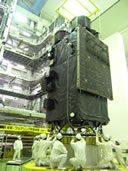
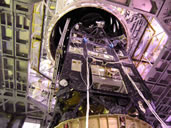
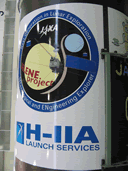
Press Release
http://www.kaguya.jaxa.jp
Those who come to Tanegashima space Science Museum in Tanegashima Space Center are folding a piece of paper into the figure of a crane birds praying for the "KAGUYA" successful launch.
2,000 crane birds or more have gathered now.
There are some crane birds in which the message is put in the inside and we felt that there are big expectation / wish from people.
As for the folded crane birds will become a "Senbazuru (*)", it is scheduled that it brings together, and the bulletin them on the wall of RCC when "KAGUYA" launch.
Please join the event when you come to the Tanegashima.
- (*) "Senbazuru (One thousand paper crane birds)"
- The crane bird(tsuru) has been a symbol of longevity along with the tortoise (kame) for centuries. The former was believed to live for a thousand years, and the latter ten thousand years. In its contemporary sense, the word 'senbazuru' commonly refers to strings of folded-paper (origami) crane birds. Customarily, one thousand small paper crane birds are folded with a prayer wishing for the quick recovery of a sick person. The folded paper crane birds are meant to show the maker's care and concern for the sick person. When a thousand paper crane birds are made, they are tied together with a few strings and presented to the sick person, who hangs them in the room for decoration.
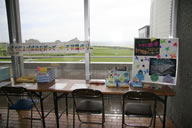
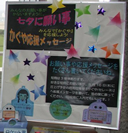
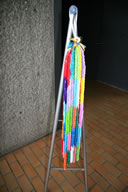
 After finishing re-assembly of KAGUYA at Tanegashima, JAXA invited mass media to show the KAGUYA to press opening to the public on June 18th. KAGUYA project members were a little bit worried about the bad weather in that day with lightning warning in the morning. Fortunately, just before the press conference, the weather became clear with blue sky. There were more mass media crews than in the past satellite press conference.
After finishing re-assembly of KAGUYA at Tanegashima, JAXA invited mass media to show the KAGUYA to press opening to the public on June 18th. KAGUYA project members were a little bit worried about the bad weather in that day with lightning warning in the morning. Fortunately, just before the press conference, the weather became clear with blue sky. There were more mass media crews than in the past satellite press conference. 
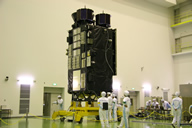
* Photo shows the launch viewing site and KAGUYA (SELENE) in TNSC.
We have opened a Special Web Site for the launch. Read more...
Launch of KAGUYA/H-IIAF13 Special Site
SELenological and ENgineering Explorer "KAGUYA"(SELENE)
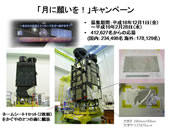 "The Wish to the Moon" name-sheets with about 410,000 name and messages were delivered to TNSC on May and attached on June 5th.
"The Wish to the Moon" name-sheets with about 410,000 name and messages were delivered to TNSC on May and attached on June 5th.They were attached just under the Solar paddle and coolers. Unfortunately, we could not see name-sheets because they were covered with MLI. However, they definitely are on SELENE and will go to the Moon.
SELENE flags are also used for the same purpose during JAXA public open day events in other JAXA's centers.
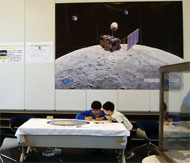
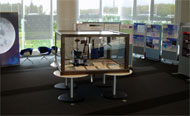
In addition, the similar event was executed even at the other office. Thank you for cooperating.
The bottom is a photo of when SELENE arrived at Tanegashima The SELENE project staff were glad to hear of the safe trip of the spacecraft from Tsukuba to Tanegashima. From now on, assembly working of SELENE is ongoing to prepare the launch in Summer.
